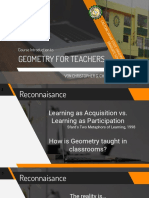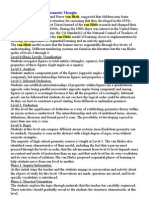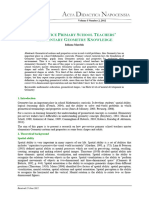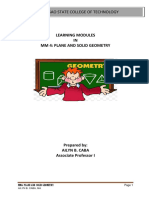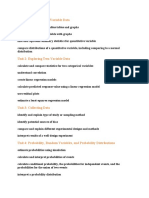2.3 The Van Hiele Theory of Geometric Thinking
2.3 The Van Hiele Theory of Geometric Thinking
Uploaded by
hasanCopyright:
Available Formats
2.3 The Van Hiele Theory of Geometric Thinking
2.3 The Van Hiele Theory of Geometric Thinking
Uploaded by
hasanOriginal Title
Copyright
Available Formats
Share this document
Did you find this document useful?
Is this content inappropriate?
Copyright:
Available Formats
2.3 The Van Hiele Theory of Geometric Thinking
2.3 The Van Hiele Theory of Geometric Thinking
Uploaded by
hasanCopyright:
Available Formats
2.
3 The van Hiele Theory of Geometric Thinking
The van Hiele Theory was developed by two Dutch mathematics educators in separate doctoral
dissertations at the University of Utrecht in 1957, Pierre Marie van Hiele, and his wife Dina van
Hiele-Geldof. The theory has been applied to explain why many students have difficulty with the
higher order cognitive processes, particularly proof, required success in high school geometry.
The van Hieles theorized that students who have trouble are being taught at a higher van Hiele
level than they are at or ready for. The theory outlines the hierarchy of levels through students’
progress as they develop geometric ideas. Put it differently, the van Hiele model explains the
stages of human geometric reasoning. The theory also offers a remedy: go through the sequence
of levels in a specific way (Usiskin, 1982). Van Hiele Levels are sequential and progress from
one level to another depends more on the content and method of instruction than on age or
biological maturation. A teaching-learning process is necessary to move the student from one
level to the next (Duatepe,2004). The theory has three aspects: the existence of levels, properties
of the levels, and the movement from one level to the next (van Hiele, 1957).
2.3.1 van Hiele Geometric Thinking Levels
van Hiele states that all students progress in geometrical thinking through five sequential and
hierarchical levels named as the levels of Recognition, Analysis, Order, Deduction, and Rigor
(van Hiele, 1959; van Hiele, 1986, van Hiele-Geldof, 1984).
2.3.1.1 Level 0 (Recognition)
At Level 0, students view figures holistically by their appearance. They can learn names of
figures and recognize a shape as a whole. For example, squares and rectangles seem to be
different. They identify shapes according to the shapes’ some physical features, such as
“largeness”, "pointedness", etc. However, they cannot notice or explain the properties of
components. If students are introduced to a certain shape, then they are able to name when they
see it again but without giving explanations concerning properties of its parts. When asked to
explain why a particular quadrilateral is a square, a typical response would be, “because it looks
like one.”. Students may be able to distinguish one figure from another simply based upon its
appearance (Usiskin, 1982).
2.3.1.2 Level 1 (Analysis)
At Analysis Level, a student can identify properties of figures. For example, the student knows
the properties of a square such as; a square has four congruent sides; a square has congruent
diagonals; a square has four right angles; the diagonals of a square bisect each other; the
diagonals of a square are perpendicular; opposite sides of a square are parallel. They reason
about geometric concepts by means of an informal analysis of shapes’ parts and properties.
These properties could be realized by a variety of activities such as observation, measuring,
cutting, and folding. At this level necessary properties of the figure could be understood.
However, each property is perceived as isolated and unrelated, no property implies any other.
Therefore, relations between properties and definitions are not understood (Duatepe, 2004)
2.3.1.3 Level 2 (Order)
Students at Level 2 can logically order figures and relationships, but still does not operate with a
mathematical system. That is, simple deduction can be followed, but proof is not understood.
Students logically order the properties of concepts, form abstract definitions, and distinguish
between the necessity and sufficiency of a set of properties in determining a concept. The
relationship between properties can be established, hierarchies can be built and the definitions
can be understood, properties of geometric figures are deduced one from others. For example, the
student can see that a square is a rectangle; but a rectangle may not be a square. However, the
importance of deduction cannot be understood at this level (Usiskin, 1982).
2.3.1.4 Level 3 (Deduction)
Students at Level 3 understand the significance of deduction and the roles of postulates,
theorems, and proof. Proofs can be developed and written with understanding. Students can
construct proofs of theorems, understand the role of axioms and definitions, and the meaning of
necessary and sufficient conditions. “Students can reason formally by logically interpreting
geometric statements such as axioms, definitions, and theorems” (Battista & Clements, 1992,
p.428). For example, students understand the fact that the definition of “quadrilaterals in which
all sides and angles are equal” and the definition of “quadrilaterals in which all angles are
perpendicular and adjacent sides are equal” could be proved to be equal and both can define a
square (Duatepe, 2004).
2.3.1.5 Level 4 (Rigor)
Students at this level are able to reason Non-Euclidean geometry and explore other axiomatic
systems. They understand the necessity for rigor and are able to make abstract deductions.
Furthermore, they are able to make connections and see relationships between different
axiomatic systems (Usiskin, 1982). Students compare different geometries based on different
axioms and study them without concrete models. They can establish consistency of a set of
axiom, and equivalence of different sets of axioms, create an axiomatic system for a geometry.
Theorems in different axiomatic systems could be established (Duatepe, 2004)
To sum up, the first level of geometric thinking begins with nonverbal thinking. The student at
level 0 perceives a figure as a whole shape and does not perceive their parts. He/she might say,
"It is a rectangle because it looks like a door". At level 1, properties can be recognized but
properties are not logically ordered yet. At level 2, properties are logically ordered; one property
precedes or follows from another property. But at this level, the intrinsic meaning of deduction,
that is, the role of axioms, definitions, theorems, and their converses are not understood. At level
3 deduction and construction of proof can be understood. Different axiomatic systems can be
understood at level 4. This model has been studied and validated by numerous researchers
(Burger & Shaughnessy, 1986; Fuys, Geddes & Tischler, 1988; Hoffer, 1981; Mayberry, 1981;
Senk, 1983; Senk, 1989; Usiskin, 1982).
2.3 Teori Berpikir Geometris
van Hiele Teori van Hiele dikembangkan oleh dua pendidik matematika Belanda dalam disertasi
doktoral terpisah di Universitas Utrecht pada tahun 1957, Pierre Marie van Hiele, dan istrinya
Dina van Hiele-Geldof. Teori ini telah diterapkan untuk menjelaskan mengapa banyak siswa
mengalami kesulitan dengan proses kognitif tingkat tinggi, terutama bukti, diperlukan
keberhasilan dalam geometri sekolah menengah. Van Hieles berteori bahwa siswa yang
mengalami kesulitan sedang diajarkan di tingkat van Hiele yang lebih tinggi daripada yang
mereka siapkan. Teori ini menguraikan hierarki tingkat melalui kemajuan siswa ketika mereka
mengembangkan ide-ide geometris. Dengan kata lain, model van Hiele menjelaskan tahap
penalaran geometris manusia. Teori ini juga menawarkan obat: melalui urutan level dengan cara
tertentu (Usiskin, 1982). Level Van Hiele berurutan dan berkembang dari satu level ke level
lainnya lebih tergantung pada konten dan metode pengajaran daripada usia atau pematangan
biologis. Sebuah proses belajar mengajar diperlukan untuk memindahkan siswa dari satu tingkat
ke yang berikutnya (Duatepe, 2004). Teori ini memiliki tiga aspek: keberadaan level, sifat level,
dan pergerakan dari satu level ke level berikutnya (van Hiele, 1957).
2.3.1 Tingkat Berpikir Geometris
van Hiele van Hiele menyatakan bahwa semua siswa mengalami kemajuan dalam pemikiran
geometris melalui lima tingkat berurutan dan hierarkis yang disebut sebagai tingkat Pengakuan,
Analisis, Urutan, Pengurangan, dan Kekakuan (van Hiele, 1959; van Hiele, 1986, van Hiele-
Geldof, 1984).
2.3.1.1 Level 0 (Pengakuan)
Pada Level 0, siswa melihat angka secara holistik berdasarkan penampilan mereka. Mereka
dapat mempelajari nama-nama tokoh dan mengenali bentuk secara keseluruhan. Sebagai contoh,
kotak dan persegi panjang tampaknya berbeda. Mereka mengidentifikasi bentuk sesuai dengan
bentuk beberapa fitur fisik, seperti "besar", "runcing", dll. Namun, mereka tidak dapat melihat
atau menjelaskan sifat-sifat komponen. Jika siswa diperkenalkan dengan bentuk tertentu , maka
mereka dapat memberi nama ketika mereka melihatnya lagi tetapi tanpa memberikan penjelasan
tentang sifat bagian-bagiannya. Ketika ditanya untuk menjelaskan mengapa segi empat tertentu
berbentuk bujur sangkar, respons khasnya adalah, "karena terlihat seperti satu.". Siswa mungkin
dapat membedakan satu sosok dari yang lain hanya berdasarkan penampilannya (Usiskin, 1982).
2.3.1.2 Level 1 (Analisis)
Pada Level Analisis, seorang siswa dapat mengidentifikasi sifat-sifat angka. Misalnya, siswa
mengetahui sifat-sifat kotak seperti; sebuah bujur sangkar memiliki empat sisi kongruen ; kotak
memiliki diagonal kongruen; kotak memiliki empat sudut kanan; diagonal -persegi persegi
membagi dua satu sama lain; diagonal bujur sangkar adalah tegak lurus; sisi berlawanan dari
sebuah kotak adalah paralel. Mereka beralasan tentang konsep-konsep geometris melalui analisis
informal atas bagian-bagian dan sifat-sifat bentuk. Properti ini dapat diwujudkan dengan
berbagai kegiatan seperti pengamatan, pengukuran, pemotongan, dan pelipatan. Pada tingkat ini ,
sifat-sifat yang diperlukan dari figur tersebut dapat dipahami. Namun, setiap properti dianggap
terisolasi dan tidak terkait, tidak ada properti menyiratkan yang lain. Oleh karena itu, hubungan
antara properti dan definisi tidak dipahami (Duatepe, 2004)
2.3.1.3 Level 2 (Orde)
Siswa di Level 2 secara logis dapat memesan angka dan hubungan, tetapi masih tidak beroperasi
dengan sistem matematika. Artinya, deduksi sederhana dapat diikuti, tetapi bukti tidak
dipahami. Siswa secara logis memesan properti konsep, membentuk definisi abstrak, dan
membedakan antara keharusan dan kecukupan seperangkat properti dalam menentukan
konsep. Hubungan antara properti dapat dibangun, hierarki dapat dibangun dan definisi dapat
dipahami, sifat - sifat tokoh geometris disimpulkan satu dari yang lain. Sebagai contoh, siswa
dapat melihat bahwa kotak adalah persegi panjang; tapi persegi panjang mungkin bukan
persegi. Namun, pentingnya deduksi tidak dapat dipahami pada tingkat ini (Usiskin, 1982).
2.3.1.4 Level 3 (Pengurangan)
Siswa di Level 3 memahami pentingnya deduksi dan peran postulat, teorema, dan bukti. Bukti
dapat dikembangkan dan ditulis dengan pemahaman. Siswa dapat membangun bukti teorema,
memahami peran aksioma dan definisi, dan makna kondisi yang diperlukan dan
memadai. “Siswa dapat bernalar secara formal dengan menafsirkan secara logis pernyataan
geometris seperti aksioma, definisi, dan teorema” (Battista & Clements, 1992, hal.428). Sebagai
contoh, siswa memahami fakta bahwa definisi "segi empat di mana semua sisi dan sudut sama"
dan definisi "segi empat di mana semua sudut tegak lurus dan sisi yang berdekatan sama" dapat
dibuktikan sama dan keduanya dapat menentukan a square (Duatepe, 2004).
2.3.1.5 Level 4 (Rigor)
Siswa pada level ini dapat menggunakan geometri Non-Euclidean dan menjelajahi sistem
aksiomatik lainnya. Mereka memahami perlunya ketelitian dan mampu membuat deduksi
abstrak. Selain itu, mereka dapat membuat koneksi dan melihat hubungan antara sistem
aksiomatik yang berbeda (Usiskin, 1982). Siswa membandingkan geometri yang berbeda
berdasarkan aksioma yang berbeda dan mempelajarinya tanpa model konkret. Mereka dapat
membangun konsistensi set aksioma, dan kesetaraan set aksioma yang berbeda, menciptakan
sistem aksiomatik untuk geometri. Teorema dalam sistem aksiomatik yang berbeda dapat
dibentuk (Duatepe, 2004)
Singkatnya, tingkat pertama pemikiran geometris dimulai dengan pemikiran nonverbal . Siswa di
level 0 memandang sosok sebagai keseluruhan bentuk dan tidak melihat bagian mereka. Dia
mungkin berkata, "Itu persegi panjang karena terlihat seperti pintu". Pada level 1, properti dapat
dikenali tetapi properti belum dipesan secara logis. Pada level 2, properti dipesan secara
logis; satu properti mendahului atau mengikuti dari properti lain. Tetapi pada tingkat ini, makna
intrinsik deduksi, yaitu, peran aksioma, definisi, teorema, dan percakapan mereka tidak
dipahami. Pada level 3, deduksi dan konstruksi bukti dapat dipahami. Sistem aksiomatik yang
berbeda dapat dipahami pada level 4. Model ini telah dipelajari dan divalidasi oleh
banyak peneliti (Burger & Shaughnessy, 1986; Fuys, Geddes & Tischler, 1988; Hoffer, 1981;
Mayberry, 1981; Senk, 1983; Senk, 1989 ; Usiskin, 1982).
You might also like
- Van Hieles ModelDocument38 pagesVan Hieles Modelapi-339611548100% (1)
- UHU005 Report - Politics Without Principles PDFDocument23 pagesUHU005 Report - Politics Without Principles PDFMani SraNo ratings yet
- Hiele Model of The Development of Geometric Thought: Maiy CrowleyDocument16 pagesHiele Model of The Development of Geometric Thought: Maiy CrowleyfjmurieldNo ratings yet
- The Van Hiele Model of The Development of Geometric ThoughtDocument16 pagesThe Van Hiele Model of The Development of Geometric Thoughtzila cuteNo ratings yet
- Research Evidence On Hierarchical Thinking, Teaching Strategies & The Van Hiele TheoryDocument37 pagesResearch Evidence On Hierarchical Thinking, Teaching Strategies & The Van Hiele TheoryMichael de VilliersNo ratings yet
- Jasneet Kaur, Mohd Mamur Ali, Ashu Threja: Understanding of Geometrical and Algebraic Concepts at Elementary LevelDocument23 pagesJasneet Kaur, Mohd Mamur Ali, Ashu Threja: Understanding of Geometrical and Algebraic Concepts at Elementary LevelAmber HabibNo ratings yet
- Gutiérrez, Á., & Jaime, A. (1998) .Document20 pagesGutiérrez, Á., & Jaime, A. (1998) .mathphysicsa7No ratings yet
- Lesson 5-Early Childhood GeometryDocument34 pagesLesson 5-Early Childhood GeometryRubie Glenn PaetNo ratings yet
- The Van Hiele Model of Geometric Thought1Document29 pagesThe Van Hiele Model of Geometric Thought1api-3732710100% (1)
- Misconceptions in Geometry and Suggested Solutions For Seventh Grade StudentsDocument13 pagesMisconceptions in Geometry and Suggested Solutions For Seventh Grade StudentsAdam SufiNo ratings yet
- The Van Hiele Levels of Geometric UnderstandingDocument6 pagesThe Van Hiele Levels of Geometric Understandingtere.ramosNo ratings yet
- Van HieleDocument10 pagesVan HieleNurul Farhana0% (1)
- A Dynamic Approach To Quadrilateral DefinitionsDocument12 pagesA Dynamic Approach To Quadrilateral DefinitionsMichael de Villiers100% (2)
- WDS12 112 m8 VojkuvkovaDocument4 pagesWDS12 112 m8 VojkuvkovaShaliny LinnieNo ratings yet
- Concept Formation Is A Creative, Not A Mechanical Passive, Process - . - ADocument18 pagesConcept Formation Is A Creative, Not A Mechanical Passive, Process - . - Aisma damai yantiNo ratings yet
- P P S T ' E G K: Reservice Rimary Chool Eachers Lementary Eometry NowledgeDocument8 pagesP P S T ' E G K: Reservice Rimary Chool Eachers Lementary Eometry NowledgecagobrtNo ratings yet
- Students Difficulties With Proofs WeberDocument9 pagesStudents Difficulties With Proofs Weberapi-339611548No ratings yet
- 1.final Thesis Van HieleDocument63 pages1.final Thesis Van HieleAnonymous 0C4RSG100% (3)
- Cabaran Dalam Pengajaran Bentuk Dan RuangDocument11 pagesCabaran Dalam Pengajaran Bentuk Dan RuangkhairulazuadhusainNo ratings yet
- Mason, Marguerite. The Van Hiele Levels of Geometric Understanding. 2002Document5 pagesMason, Marguerite. The Van Hiele Levels of Geometric Understanding. 2002Azrina MahmudNo ratings yet
- Geometry and Spatial ReasoningDocument11 pagesGeometry and Spatial ReasoningKok An KohNo ratings yet
- 3040 ICET Veronika+Fitri+RianasariDocument6 pages3040 ICET Veronika+Fitri+RianasariRiky NuzzNo ratings yet
- How Structure Sense For Algebraic Expressions or Equations Is Related To Structure Sense For Abstract AlgebraDocument12 pagesHow Structure Sense For Algebraic Expressions or Equations Is Related To Structure Sense For Abstract Algebraidmejia25No ratings yet
- Misconceptions in Geometry and Suggested Solutions For Seventh Grade StudentsDocument13 pagesMisconceptions in Geometry and Suggested Solutions For Seventh Grade StudentsichalNo ratings yet
- Intuitive Nonexamples: The Case of Triangles: Educ Stud Math (2008) 69:81 - 95 DOI 10.1007/s10649-008-9133-5Document15 pagesIntuitive Nonexamples: The Case of Triangles: Educ Stud Math (2008) 69:81 - 95 DOI 10.1007/s10649-008-9133-5Nicolás Sánchez AcevedoNo ratings yet
- Sets ResearchDocument53 pagesSets ResearchMarc Jason LanzarroteNo ratings yet
- Van Hiles Theory of Geometric ThinkingDocument15 pagesVan Hiles Theory of Geometric ThinkingJason Andres Diaz SuarezNo ratings yet
- Preservice Mathematics Teachers' Understandings of The Class Inclusion Between Kite and SquareDocument7 pagesPreservice Mathematics Teachers' Understandings of The Class Inclusion Between Kite and SquarehestizaNo ratings yet
- 776 1378 1 SMDocument9 pages776 1378 1 SMFIRDHA RAZAKNo ratings yet
- FULLTEXT01Document10 pagesFULLTEXT01Nauman ChannaNo ratings yet
- Bailera, A., & Manero, V. (2023) .Document24 pagesBailera, A., & Manero, V. (2023) .mathphysicsa7No ratings yet
- Primer RadaDocument13 pagesPrimer RadaMarija DinovNo ratings yet
- Developing A Local Instruction Theory For Learning The Concept of Angle Through Visual Field Activities and Spatial RepresentationsDocument13 pagesDeveloping A Local Instruction Theory For Learning The Concept of Angle Through Visual Field Activities and Spatial RepresentationsMuhammad Husnul KhuluqNo ratings yet
- Parameswaran, R. (2006) - On Understanding The Notion of Limits and Infinitesimal Quantities.Document24 pagesParameswaran, R. (2006) - On Understanding The Notion of Limits and Infinitesimal Quantities.mayrulo413No ratings yet
- Van Hiele Levels and Achievement in Writing Geometry Proofs - Reaction PaperDocument2 pagesVan Hiele Levels and Achievement in Writing Geometry Proofs - Reaction PaperEmjoyNo ratings yet
- The Van Hiele ModelDocument10 pagesThe Van Hiele ModelCrystal100% (1)
- GeometrystrategiesDocument11 pagesGeometrystrategiesKARIZZA ABOLENCIANo ratings yet
- MIP2601 Assignment 2 2024Document13 pagesMIP2601 Assignment 2 2024jametrabuckles102No ratings yet
- Generalisation, Abstraction and Angles: An NCETM Research Study ModuleDocument32 pagesGeneralisation, Abstraction and Angles: An NCETM Research Study ModuleԱբրենիկա ՖերլինNo ratings yet
- Mathematics Underachievers Learning Spatial Knowledge: John MunroDocument9 pagesMathematics Underachievers Learning Spatial Knowledge: John Munromaje2013No ratings yet
- Understanding The Meaning of Tens and Units in Multi-Digit NumbersDocument35 pagesUnderstanding The Meaning of Tens and Units in Multi-Digit NumbersMuhammad Randy SyechbubakarNo ratings yet
- Learning and Teaching of Three-Dimensional SolidsDocument11 pagesLearning and Teaching of Three-Dimensional Solidsapi-325255998No ratings yet
- Seeking More Than Nothing: Two Elementary Teachers' Conceptions of ZeroDocument36 pagesSeeking More Than Nothing: Two Elementary Teachers' Conceptions of ZeroMunajibNo ratings yet
- Topic 10 Two Dimensional Shapes (2D)Document33 pagesTopic 10 Two Dimensional Shapes (2D)Finely MimieeNo ratings yet
- BF 03217055Document24 pagesBF 03217055Carlos HidalgoNo ratings yet
- 608-Article Text (Blinded) - 1083-1-10-20190405Document18 pages608-Article Text (Blinded) - 1083-1-10-20190405Bop DongNo ratings yet
- Faculty of Education and Languages May Semester /2012 CODE: HBMT4103 Title: Teaching Mathematics in Form ThreeDocument10 pagesFaculty of Education and Languages May Semester /2012 CODE: HBMT4103 Title: Teaching Mathematics in Form ThreeznurulaiinNo ratings yet
- Word Template For Authors, EIAS Style BDocument13 pagesWord Template For Authors, EIAS Style BJothy GnanaNo ratings yet
- Investigation of Seventh Grade Students Van Hiele Geometric Thinking Levels in Circle SubjectDocument24 pagesInvestigation of Seventh Grade Students Van Hiele Geometric Thinking Levels in Circle SubjectSevim SevgiNo ratings yet
- Foundation Phase Teachers' (Limited) Knowledge of GeometryDocument16 pagesFoundation Phase Teachers' (Limited) Knowledge of Geometrynosipho mbuthumaNo ratings yet
- Could Exist The Cognitive Theory inDocument12 pagesCould Exist The Cognitive Theory inMi RoNo ratings yet
- Issues Teach MeasureDocument2 pagesIssues Teach MeasureVILASHINI A/P ALAGANDARAN IPGKTINo ratings yet
- Semi Detailed Lesson Plan Points, Lines PlanesDocument3 pagesSemi Detailed Lesson Plan Points, Lines PlanesKatherine Ilac BravoNo ratings yet
- Level 0: VisualizationDocument6 pagesLevel 0: VisualizationLi Jing YauNo ratings yet
- Van Hiele Levels OneDocument23 pagesVan Hiele Levels OneSaiful RidzwanNo ratings yet
- Some Reflections On The Van Hiele TheoryDocument36 pagesSome Reflections On The Van Hiele TheoryNurul Fitriany AbbasNo ratings yet
- d-LECTURE 3Document23 pagesd-LECTURE 3ChristineNo ratings yet
- 237 647 3 PBDocument16 pages237 647 3 PBAziz Rizky MuhdiyantoNo ratings yet
- Module in Plane Solid Geo CompleteDocument172 pagesModule in Plane Solid Geo Completelloydie bantigueNo ratings yet
- LESSON 3-4 3rd GRADE CLASS H, I, G, B - Print - QuizizzDocument5 pagesLESSON 3-4 3rd GRADE CLASS H, I, G, B - Print - QuizizzhasanNo ratings yet
- Shaping The Standards:: "Higher Standards For Our Students, Higher Standards For Ourselves"Document2 pagesShaping The Standards:: "Higher Standards For Our Students, Higher Standards For Ourselves"hasanNo ratings yet
- Van Hiele Thinking Level and Geometry Visual SkillDocument8 pagesVan Hiele Thinking Level and Geometry Visual SkillhasanNo ratings yet
- Shaping The Standards:: "Higher Standards For Our Students, Higher Standards For Ourselves"Document2 pagesShaping The Standards:: "Higher Standards For Our Students, Higher Standards For Ourselves"hasanNo ratings yet
- The Van Hiele Analysis of Curricular Materials - A Comparative StuDocument156 pagesThe Van Hiele Analysis of Curricular Materials - A Comparative StuhasanNo ratings yet
- Kompre Februari 2019Document1 pageKompre Februari 2019hasanNo ratings yet
- 40 Solved MCQs of STA630 - Research MethodsDocument14 pages40 Solved MCQs of STA630 - Research MethodsPower Girls84% (141)
- How To Write A Philosophy PaperDocument3 pagesHow To Write A Philosophy PaperThedudeNo ratings yet
- Ratzinger. Consciousness and TruthDocument10 pagesRatzinger. Consciousness and TruthJarekNo ratings yet
- Charles Law. NewDocument5 pagesCharles Law. NewMarvin Agustin100% (1)
- American Association For Laboratory AccreditationDocument34 pagesAmerican Association For Laboratory AccreditationVolca CmmNo ratings yet
- Chapter 3, 4Document14 pagesChapter 3, 4anmar ahmedNo ratings yet
- Unit 1: Exploring One-Variable DataDocument3 pagesUnit 1: Exploring One-Variable DatajafNo ratings yet
- Concept of Soul or AtmanDocument2 pagesConcept of Soul or AtmanMani SoniNo ratings yet
- Elements of Human ActDocument2 pagesElements of Human ActRegine Lorenzana Mey-Ang100% (6)
- Critical Thinking SlideDocument22 pagesCritical Thinking SlideAmilin HatiaraNo ratings yet
- Floydeth V. Cortez Dissertation SeminarDocument20 pagesFloydeth V. Cortez Dissertation SeminarYannah HidalgoNo ratings yet
- Experimental Psychology: Ma'Am Lois LopezDocument74 pagesExperimental Psychology: Ma'Am Lois LopezDrixson DwightNo ratings yet
- The Five Basic Styles of CommunicationDocument29 pagesThe Five Basic Styles of CommunicationVy PhươngNo ratings yet
- Chapter 1-The Process of Auditing Information SystemsDocument50 pagesChapter 1-The Process of Auditing Information SystemsSritrusta SukaridhotoNo ratings yet
- 2.3 The Precise Definition of A LimitDocument8 pages2.3 The Precise Definition of A Limitसौरव डेNo ratings yet
- Reading Is A Complex Cognitive Process of Decoding Symbols in Order To Construct or Derive MeaningDocument3 pagesReading Is A Complex Cognitive Process of Decoding Symbols in Order To Construct or Derive MeaningLutfan La100% (1)
- Bootstrapping: Bias StatisticDocument2 pagesBootstrapping: Bias StatisticMartin StojanovicNo ratings yet
- Second Chance To Make The Right ImpressionDocument3 pagesSecond Chance To Make The Right ImpressionKaustav PalitNo ratings yet
- Samenvatting2 PDFDocument40 pagesSamenvatting2 PDFKlfjqFsdafdasfNo ratings yet
- Vigotski, L. S. Luria, A. R. (1994) - Introduction To The Russian Translation of Freud S Beyond The Pleasure PrincipleDocument9 pagesVigotski, L. S. Luria, A. R. (1994) - Introduction To The Russian Translation of Freud S Beyond The Pleasure PrincipleMacla R. NunesNo ratings yet
- What Is Metrological TraceabilityDocument18 pagesWhat Is Metrological TraceabilityDanish Ahmed AlviNo ratings yet
- Chapter Three MultipleDocument15 pagesChapter Three MultipleabdihalimNo ratings yet
- Types of SimulationDocument7 pagesTypes of SimulationMani KandanNo ratings yet
- Probability and Statistics 2019 June QBDocument16 pagesProbability and Statistics 2019 June QBsravaniNo ratings yet
- Constructive ResearchDocument20 pagesConstructive ResearchArivian MangilayaNo ratings yet
- SPSS Ott Survey OutputDocument8 pagesSPSS Ott Survey OutputjatinNo ratings yet
- Alistair Savage - Mathematical Reasoning & Proofs (Lecture Notes) (2017)Document93 pagesAlistair Savage - Mathematical Reasoning & Proofs (Lecture Notes) (2017)AlkhaelNo ratings yet
- 1404 3371Document11 pages1404 3371Daniel G.G.No ratings yet
- Noble Eightfold Path-Q&A - SangharakishtaDocument369 pagesNoble Eightfold Path-Q&A - Sangharakishtamuds tNo ratings yet
